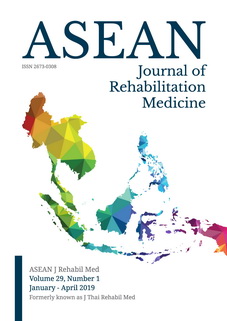Outcomes of Intermediate Phase Post-Stroke Inpatient Rehabilitation in Community Hospital
ผลลัพธ์ของการฟื้นฟูสมรรถภาพระยะกลางสำหรับผู้ป่วยโรคหลอดเลือดสมอง แบบผู้ป่วยในของโรงพยาบาลระดับชุมชน
Keywords:
Keywords: Intermediate care service, Outcome of rehabilitation, Inpatient rehabilitation, Community hospitalAbstract
Objectives: To study outcomes of intermediate care service including functional gain, effectiveness, efficiency and length of stay of stroke patients admitted for inpatient rehabilitation at a community hospital.
Study design: Retrospective study.
Setting: Luangphopern Hospital, Nakhonpathom province.
Subjects: Intermediate phase stroke patients admitted for inpatient rehabilitation during March 2016 – November 2018
Methods: Demographic data, Barthel Index (BI) at admission (BIA) and discharge (BID), length of stay (LOS) and complication were extracted from medical records.Functional gain (∆BI=BID –BIA), rehabilitation effectiveness (∆BI divided by difference of maximum BI and BID x 100%), and rehabilitation efficiency (∆BI divided by LOS) were calculated.
Results: Of 72 stroke patients, 72.2% were males, 59.7% had ischemic stroke, and mean age was 61.17 (SD 14.48) years. At discharge, the BI increased significantly (p<0.001) with mean functional gain of 6.56 (SD 4.48). Mean percentage of rehabilitation effectiveness was 56.62 (SD 33.15) and mean rehabilitation efficiency was 0.22 (SD 0.18). Average LOS was 35.65 days. Fifteen patients (20.1%) had at least one complication. The most common complication was urinary tract infection.
Conclusion: Intermediate phase post-stroke patients receiving inpatient rehabilitation at a community hospital had statistically significant improvement in functional score. Rehabilitation efficiency in this study was approximate to the previous multicenter study of inpatient stroke rehabilitation service in Thailand.
Keywords: Intermediate care, rehabilitation outcome, stroke, inpatients, community hospital
References
2. The Ministry of Public Health. Intermediate care service plan [Internet]. 2560. [Cited 2017 November 20]. Available from URL: https://www.snmri.go.th/snmri/download/train/pm/Intermediate_1.pdf.
3. Wivatvanit S, Jitapunkul S, Ketphichonwatna C. The study “Readiness and needs of patients who have been discharged from hospitals in general hospitals and central hospitals under the Ministry of Public Health: One day survey. [Internet]. 2012. [Cited 2018 April 20]. Available from URL: https://thaitgri.org/?p=37374.
4. Vichathai J, Srithamrongsawat S, RiewpaiboonV, Kongsawat S, Thomroj N, Aiemnoi P, et al. A study of services and costs of intermediate care services. Bangkok: Health insurance system research office; 2009.
5. Rønning OM, Guldvog B. Outcome of subacute stroke rehabilitation: a randomized controlled trial. Stroke. 1998;29:779-84.
6. Ozdemir F, Birtane M, Tabatabaei R, Kokino S, Ekuklu G. Comparing stroke rehabilitation outcomes between acute inpatient and non intense home settings. Arch Phys Med Rehabil. 2001;82:1375-9.
7. Dajpratham P, Meenaphant R, Junthon P, Pianmanakij S, Jantharakasamjit S, Yuwan A. The inter-rater reliability of Barthel Index (Thai version) in stroke patients. J Thai Rehabil Med. 2006; 16:1-9.
8. Wade D, Hewer R. Functional abilities after stroke: measurement, natural history and prognosis. J Neurol Neurosurg Psychiat. 1987;50:177-82.
9. Wade D, Collin C. The Barthel ADL Index: a standard measure of physical disability? IntDisabil Stud. 1998;10:64-7.
10. Pattanasuwanna P, Kuptniratsaikul V. Inpatient rehabilitation outcomes in patients with stroke at Thailand’s largest tertiary referral center: a 5-year retrospective study. J Sci Res Stud. 2017;4:208-16.
11. Chen C, Koh GC, Naidoo N, Cheong A, Fong NP, Tan YY, et al. Trends in length of stay, functional outcomes, and discharge destination stratified by disease type for inpatient rehabilitation in Singapore community hospitals from 1996 to 2005. Arch Phys Med Rehabil. 2013;94:1342-51.
12. Tongchai A, Arayathanitkul K, Soankwan C, Emarat N, Chitaree R, et al. Normalized Gain: a new assessment method by using pre-test and post-test scores[Internet].n.d.[Cited 2018 October 19].Available from URL:https://penthai.sc.mahidol.ac.th/html/articles/normalized_gain.pdf.
13. Shah S, Vanclay F, Cooper B. Efficiency, effectiveness, and duration of stroke rehabilitation. Stroke. 1990;21:241-6.
14. Department of Health, Ministry of Public Health.Elements of district health care implementation for the elderly. [Internet]. 2014 [Cited 2018 June 3]. Available fromURL: https://www.udo.moph.go.th/thepost/upload/UX4ctZPFMRiXzczWnqcMqylj5O/EgzvAFiPptt9hEgeHvmTU5Xuwo.doc.
15. Kuptniratsaikul V, Wattanapan P, Wathanadilokul U, Sukonthamarn K, Lukkanapichonchut P, Ingkasuthi K, et al. The Effectiveness and efficiency of inpatient rehabilitation services in Thailand: a prospective multicenter study. Rehabil Process Outcome. 2016;5:13-8.
16. Kuptnirasaikul V, Kovindha A, Dajpratham P, Piravej K. Main outcomes of stroke rehabilitation: a multi-centre study in Thailand. J Rehabil Med. 2009;41:54-8.
17. Wang H, Camicia M, DiVita M, Mix J, Niewczyk P. Early inpatient rehabilitation admission and stroke patient outcomes. Am J Phys Med Rehabil. 2015;94:85-96.
18. Wang H, Camicia M, Terdiman J, Hung YY, Sandel ME. Time to inpatient rehabilitation hospital admission and functional outcomes of stroke patients. PMR. 2011;3:296-304.
19. Salter K, Jutai J, Hartey M, Foley N, Bhogal S, Bayano N, et al. Impact of early vs delayed admission to rehabilitation on functional outcomes in persons with stroke. J Rehabil Med. 2006;38:113-7.






